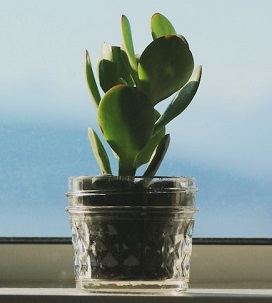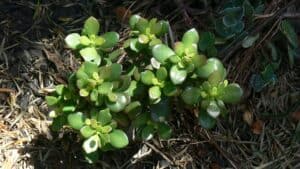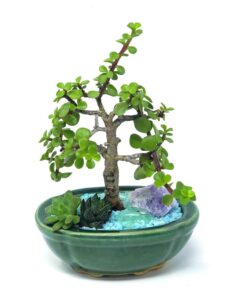World-famous houseplants include jade plants. Plant lovers love them for their spectacular look and ease of care. Jade plants, like any plants, may have growth and aesthetic difficulties. Leggy stems may make the plant seem ill.
This article describes leggy jade plants and their causes. We’ll also provide ways to fix this and make your jade plant bushier.
What Does a Leggy Jade Plant Look Like?
Leggy jade plants looks like tall with sparse stems. Etiolation, natural for jade plants, makes the plant seem scraggly and ill. Overfertilization and lack of light may make jade plants leggy. If the whole plant is lanky, pruning up to one-third of each stem right above a node might stimulate bushier growth.
To get more light, jade plants produce lanky stalks. Overfertilization causes lanky growth by diverting energy from leaf development to stem growth.
To bush out a leggy jade plant, trim one-third of each stem right above a node. The plant will grow new leaves from the surviving stem.
Causes of Leggy Growth in Jade Plants
There are several reasons why jade plants may become leggy:
- Insufficient Sunlight: Jade plants need strong, indirect sunshine. Leggy growth results from insufficient light.
Overfertilization: Jade plants are slow-growing. Overfertilization makes plants lanky because they focus on stem development rather than leaf formation. - Over or underwatering jade plants may cause lanky growth. Overwatering may promote root rot, which diverts energy from leaf creation to stem growth. Stress from underwatering may induce leggy stems.
- Weak Soil: Jade plants need well-draining, nutrient-rich soil. Low soil quality might make the plant develop stems instead of leaves.
- Lack of Pruning: Without pruning, jade plants focus on stem development rather than leaf formation, making them lanky.

How to Fix Leggy Growth in Jade Plants
- Jade plants need bright, indirect sunshine. Give your plant ample sunshine.
- Jade plants need deep, infrequent watering. To avoid overwatering or underwatering, let the soil dry between waterings.
- Minimize Fertilization: Jade plants need little fertilising. Fertilize monthly throughout growth season.
- Repot: If your jade plant is growing in poor soil, repot it in well-draining, nutrient-rich soil.
- Pruning jade plants regularly prevents leggy growth. For bushier growth, cut stems above a node.

| Specification | Description |
|---|---|
| Plant | Jade Plant (Crassula ovata) |
| Issue | Leggy appearance |
| Causes | Inadequate light or nutrients, incorrect pruning, overwatering or underwatering |
| Symptoms | Stems appear elongated and thin, with large gaps between leaves, and may bend or break under the weight of leaves |
| Treatment | Provide better light and proper nutrients, adjust watering frequency and quantity, prune back overgrown branches, support plant with stakes or ties |
| Prevention | Provide adequate light and avoid overwatering or underwatering, prune plant regularly to maintain shape |
| Environment | Native to South Africa, but widely cultivated as a houseplant or outdoor plant |
| Appearance | Succulent plant with thick, fleshy leaves and woody stems |
| Light Requirements | Bright, indirect light or filtered sun exposure |
| Water Requirements | Infrequent watering, allowing soil to dry out between waterings |
| Soil Requirements | Well-draining soil with a pH of 6.0 to 7.5 |
| Maintenance | Minimal maintenance required, occasional fertilization to promote growth, prune to maintain shape |
How to Prevent Leggy Jade Plants?
Proper growth conditions will keep your jade plant from being lanky. Tips for keeping your jade plant healthy and bushy:
Provide Adequate Light

Jade plants need bright, indirect light. Put your plant near a window that gets 4-6 hours of strong, filtered light. If you don’t have a sunny window, use grow lights.
Water Correctly
Succulent jade plants conserve water. Overwatering may cause root rot and other issues, so let the soil dry out between waterings.
Use Fertilizer Sparingly
Slow-growing jade plants need little fertiliser. Overfertilization causes lanky growth and other difficulties. Fertilize your jade plant monthly using a balanced, water-soluble fertiliser.
Prune Regularly

Pruning promotes branching and bushiness, preventing lanky growth. Pinch new growth tips to induce branching, and clip leggy stems to just above a node to promote new growth.
Frequently Asked Questions (FAQs)
How do I make my jade plant bushy?
One of the easiest ways to make your jade plant bushier is through regular pruning. By snipping or pinching off the newly sprouted leaves on the end of each branch, you can encourage the plant to branch out more, resulting in a fuller appearance. While it may seem counterintuitive to cut off new growth, this technique is actually effective in promoting branching and a bushier appearance.
Another way to make your jade plant bushier is to plant multiple plants in one pot. By planting 2-3 plants together, you can create a fuller, bushier look. Additionally, planting multiple plants in one pot can help to evenly distribute growth and support the weight of the plants as they grow.
Pruning the jade plant at the base of its stem can also encourage bushier growth. This technique involves cutting back the main stem of the plant to a lower node or leaf, which can help to stimulate new growth and branching. However, it is important to be careful not to over-prune the plant, as this can cause stress and potentially harm the plant.
Regular pruning and proper care are key to maintaining a bushy, healthy jade plant. Be sure to provide your plant with adequate sunlight, well-draining soil, and proper watering to help promote healthy growth. With these techniques, you can easily transform your tall, spindly jade plant into a full and bushy specimen that is sure to impress.
How far down can you cut a jade plant?
If you’re wondering how far down you can cut a jade plant, there are a few factors to consider.
First, it’s important to understand why you might want to prune your jade plant. Pruning can help to control the size and shape of the plant, encourage new growth, and remove dead or damaged leaves and branches. Depending on your goals for your jade plant, different pruning techniques may be appropriate.
If you want to encourage upward growth, you can trim the side shoots by no more than half and prune new branches only at the tips of the shoots. For outward growth, you can shorten the trunk by one-third. Relief pruning may also be necessary for older plants with drooping branches.
If your jade plant is leggy and you want to encourage bushier growth, you can cut up to one-third of each stem just above a node. This will stimulate new growth and result in a fuller, more compact plant. When pruning jade plants, it’s important not to remove more than 20 to 30 percent of the branches, as this can shock the plant and harm its overall health.
When you’re ready to prune your jade plant, start by mentally picturing which branches you would like to remove. The goal is to cut back the longest, leggiest branches and pinch out the tips on the shorter ones. When making cuts, be sure to prune each branch just above a set of leaves, as this will encourage new growth and prevent unsightly dead ends.
How do you get a woody stem on a jade plant?
If you’re wondering how to encourage your jade plant to develop a woody stem, there are a few key factors to consider.
One of the most important factors for developing a woody stem on a jade plant is sunlight. Jade plants require plenty of bright, direct sunlight to thrive and grow properly. In order to develop a thick, sturdy stem, your jade plant needs to receive enough sunlight to support its growth. If your jade plant is not receiving enough sunlight, it may become leggy or spindly, which can lead to weak stems and branches.
In addition to providing enough sunlight, it’s important to water your jade plant properly in order to encourage healthy growth. Jade plants are succulents, which means that they store water in their leaves and stems. They are adapted to arid environments, and can survive long periods of drought. However, it’s important to avoid overwatering your jade plant, as this can lead to root rot and other problems.
To encourage your jade plant to develop a woody stem, you should allow the soil to dry out between waterings. This will help the plant to conserve water and develop a strong, sturdy stem. It’s also a good idea to use a well-draining soil mix that allows excess water to drain away from the roots.
Finally, it’s worth noting that the appearance of a woody stem on a jade plant is not the only factor that contributes to its beauty. As a jade plant matures, its leaves or tips may also start to turn red, which can make it even more appealing. This color change is a natural response to changes in light and temperature, and is a sign that your jade plant is healthy and thriving.
How do you save leggy Jade?
One of the main reasons why a jade plant becomes leggy is due to insufficient sunlight. When a jade plant is not getting enough light, its leaves become elongated as they reach towards the light source, resulting in a stretched-out appearance.
To save your leggy jade plant, the first thing you should do is to provide it with enough sunlight. Jade plants require bright, direct sunlight for at least four hours a day to thrive. Move your jade plant to a spot in your home that receives plenty of natural light. If you don’t have a suitable spot, consider using artificial light sources such as grow lights to supplement natural light.
In addition to providing enough sunlight, you can also fix a leggy jade plant by selectively pruning stretched stems to encourage new growth. To do this, cut back the leggy stems just above a node, or the point where the leaves grow out from the stem. Cutting the stem in this way will encourage new growth and help to make the plant bushier.
Another option is to pinch off the growing tips of the stems. This will encourage the plant to grow sideways instead of upwards, which can help to create a fuller, more compact appearance.
If your jade plant has become overgrown and is taking up too much space, you can also cut it back to control its size. The best way to do this is to cut the stems back by one-third, just above a node. This will encourage new growth and help to create a more compact, bushy plant.
Finally, it’s important to maintain the right temperature and humidity levels for your jade plant. Keep the temperature between 65 and 75 degrees Fahrenheit during the day and between 50 and 55 degrees Fahrenheit at night. Make sure to avoid exposing your jade plant to drafts or sudden changes in temperature, as this can stress the plant and cause it to drop leaves.
Q: Can you propagate a leggy jade plant?
A: You may root stem cuttings of a leggy jade plant in water or soil. Remove lower leaves by cutting a stem above a node with a sharp, clean knife. Before planting, let the cutting dry out.
Q: What are some common problems that can cause leggy growth in jade plants?
Jade plants may develop legginess due to overwatering, underlighting, and overfertilization.
Q: Can you fix a leggy jade plant?
Pruning and proper care may repair a leggy jade plant. To promote new development, cut the stems above a node and water and light your plant.
Conclusion
With proper care, a leggy jade plant may become bushy and healthy. To avoid leggy growth, water, fertilize, and trim your jade plant. Don’t worry about leggy plants. To revive your plant, follow the aforementioned steps.
Related Posts:
Check out this article on jade plant caring and growing – Click here.
Jade Plant Branches Top Heavy – 3 Main Causes And Fix
Jade Plant Cannot Support Itself – Main Causes Why It Falls?
Jade Plant Meaning – Symbolism(Spiritual), Feng Shui
6 Amazing Benefits of Jade Plant, Uses(Superstition, Feng Shui)
Are Jade plant Toxic to Cats? – Humans, Dogs(Is It Safe)
